Readings Newsletter
Become a Readings Member to make your shopping experience even easier.
Sign in or sign up for free!
You’re not far away from qualifying for FREE standard shipping within Australia
You’ve qualified for FREE standard shipping within Australia
The cart is loading…






This title is printed to order. This book may have been self-published. If so, we cannot guarantee the quality of the content. In the main most books will have gone through the editing process however some may not. We therefore suggest that you be aware of this before ordering this book. If in doubt check either the author or publisher’s details as we are unable to accept any returns unless they are faulty. Please contact us if you have any questions.
Focusing on yellow fever, cholera, and plague epidemics as well as on sanitation in the context of urban growth in Saint-Louis-du-Senegal between 1867 and 1920, this book explores how the French colonial and medical authorities responded to the emergence and re-emergence of deadly epidemic diseases and environmental contamination. Official reactions ranged from blaming the Africans and the tropical climate to the imposition of urban residential segregation and strictly enforced furloughs of civil servants and European troops. Drastic and disruptive sanitary measures led to a conflict between the interests of competing conceptions of public health and those of commerce, civil liberties, and popular culture. This book also examines the effort undertaken by the colonizer to make Senegal a healthy colony and Saint-Louis the healthiest port-city/capital through better hygiene, building codes, vector control, and the construction of waterworks and a sewerage system. The author offers insight into the urban processes and daily life in a colonial city during the formative years of the French empire in West Africa.
$9.00 standard shipping within Australia
FREE standard shipping within Australia for orders over $100.00
Express & International shipping calculated at checkout
This title is printed to order. This book may have been self-published. If so, we cannot guarantee the quality of the content. In the main most books will have gone through the editing process however some may not. We therefore suggest that you be aware of this before ordering this book. If in doubt check either the author or publisher’s details as we are unable to accept any returns unless they are faulty. Please contact us if you have any questions.
Focusing on yellow fever, cholera, and plague epidemics as well as on sanitation in the context of urban growth in Saint-Louis-du-Senegal between 1867 and 1920, this book explores how the French colonial and medical authorities responded to the emergence and re-emergence of deadly epidemic diseases and environmental contamination. Official reactions ranged from blaming the Africans and the tropical climate to the imposition of urban residential segregation and strictly enforced furloughs of civil servants and European troops. Drastic and disruptive sanitary measures led to a conflict between the interests of competing conceptions of public health and those of commerce, civil liberties, and popular culture. This book also examines the effort undertaken by the colonizer to make Senegal a healthy colony and Saint-Louis the healthiest port-city/capital through better hygiene, building codes, vector control, and the construction of waterworks and a sewerage system. The author offers insight into the urban processes and daily life in a colonial city during the formative years of the French empire in West Africa.